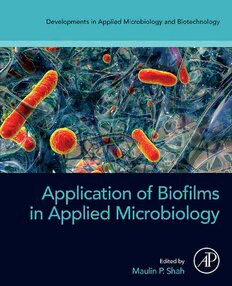
Application of Biofilms in Applied Microbiology PDF
Preview Application of Biofilms in Applied Microbiology
Application of Biofilms in Applied Microbiology This pageintentionallyleftblank Developments in Applied Microbiology and Biotechnology Application of Biofilms in Applied Microbiology Edited by Maulin P. Shah Industrial Wastewater Research Laboratory, Division of Applied & Environmental Microbiology, Enviro Technology Limited, Ankleshwar, Gujarat, India AcademicPressisanimprintofElsevier 125LondonWall,LondonEC2Y5AS,UnitedKingdom 525BStreet,Suite1650,SanDiego,CA92101,UnitedStates 50HampshireStreet,5thFloor,Cambridge,MA02139,UnitedStates TheBoulevard,LangfordLane,Kidlington,OxfordOX51GB,UnitedKingdom Copyright©2022ElsevierInc.Allrightsreserved. Nopartofthispublicationmaybereproducedortransmittedinanyformorbyanymeans,electronicormechanical, includingphotocopying,recording,oranyinformationstorageandretrievalsystem,withoutpermissioninwriting fromthepublisher.Detailsonhowtoseekpermission,furtherinformationaboutthePublisher’spermissionspolicies andourarrangementswithorganizationssuchastheCopyrightClearanceCenterandtheCopyrightLicensing Agency,canbefoundatourwebsite:www.elsevier.com/permissions. ThisbookandtheindividualcontributionscontainedinitareprotectedundercopyrightbythePublisher (otherthanasmaybenotedherein). Notices Knowledgeandbestpracticeinthisfieldareconstantlychanging.Asnewresearchandexperiencebroadenour understanding,changesinresearchmethods,professionalpractices,ormedicaltreatmentmaybecomenecessary. Practitionersandresearchersmustalwaysrelyontheirownexperienceandknowledgeinevaluatingandusingany information,methods,compounds,orexperimentsdescribedherein.Inusingsuchinformationormethodsthey shouldbemindfuloftheirownsafetyandthesafetyofothers,includingpartiesforwhomtheyhaveaprofessional responsibility. Tothefullestextentofthelaw,neitherthePublishernortheauthors,contributors,oreditors,assumeanyliabilityfor anyinjuryand/ordamagetopersonsorpropertyasamatterofproductsliability,negligenceorotherwise,orfrom anyuseoroperationofanymethods,products,instructions,orideascontainedinthematerialherein. ISBN:978-0-323-90513-8 ForInformationonallAcademicPresspublications visitourwebsiteathttps://www.elsevier.com/books-and-journals Publisher:StacyMasucci AcquisitionsEditor:LindaVersteeg-Buschman EditorialProjectManager:BillieJeanFernandez ProductionProjectManager:SwapnaSrinivasan CoverDesigner:GregHarris TypesetbyMPSLimited,Chennai,India Contents List of contributors...............................................................................................xv Chapter 1:Bacterial extracellular polysaccharides in biofilm formation and function................................................................................................ 1 Dibyajit Lahiri, Moupriya Nag, Bandita Dutta, Ankita Dey and Rina Rani Ray 1.1 Introduction...........................................................................................................1 1.2 Exopolysaccharides associated with the matrix of biofilm.....................................3 1.2.1 Various types of architectural polysaccharides associated with the biofilm..........................................................................................3 1.3 Variation in structural components of bacterial EPS..............................................9 1.4 EPS variation in gram-positive and gram-negative bacteria.................................10 1.4.1 Gram-positive bacteria..............................................................................10 1.4.2 Gram-negative bacteria.............................................................................11 1.5 Various methods of exopolysaccharide extraction from the matrix of biofilm.................................................................................................12 1.6 Functional attributes of EPS................................................................................13 1.6.1 Adhesion/cohesion/genetic material transfer.............................................14 1.6.2 Symbiosis.................................................................................................14 1.6.3 Development of pathogenicity..................................................................15 1.6.4 Source of nutrition....................................................................................15 1.6.5 Protection from antimicrobials..................................................................15 1.7 Mechanism of formation of microbial aggregates by Extracellular Polymeric Substances (EPS)................................................................................16 1.7.1 Intracellular adhesion by EPS...................................................................17 1.7.2 Conditions influencing EPS formation and action.....................................17 1.8 Applications of EPS in biotechnology.................................................................18 1.9 Conclusion...........................................................................................................20 References...................................................................................................................20 v vi Contents Chapter 2:Pseudomonas putida biofilm: development and dynamics.................... 25 Sougata Ghosh, Bhavtosh A. Kikani and Raymond J. Turner 2.1 Introduction.........................................................................................................25 2.2 Biofilm formation................................................................................................27 2.3 Factors affecting Pseudomonas putida biofilm....................................................28 2.3.1 Dynamic nature.........................................................................................29 2.3.2 Flagella.....................................................................................................29 2.3.3 Starvation stress........................................................................................31 2.4 Genetics of Pseudomonas putida biofilm.............................................................32 2.5 Biofilm control strategies.....................................................................................32 2.5.1 Physical methods......................................................................................33 2.5.2 Chemical methods.....................................................................................34 2.5.3 Biological methods...................................................................................40 2.6 Conclusions and future perspectives....................................................................42 References...................................................................................................................43 Chapter 3:Biofilm matrix proteins ....................................................................... 51 Surbhi Sharma, Mukesh Meena, Avinash Marwal and Prashant Swapnil 3.1 Introduction.......................................................................................................51 3.2 Biofilm matrix...................................................................................................53 3.3 Biofilm matrix proteins......................................................................................54 3.4 Accumulation-associated protein........................................................................54 3.5 Rugosity and biofilm structure modulator A......................................................56 3.6 Biofilm-associated protein.................................................................................57 3.7 Biofilm-surface layer protein.............................................................................57 3.8 GlcNAc-Binding protein A................................................................................58 3.9 Techniques to extract extracellular matrix from bacterial biofilms.....................59 3.10 Conclusion.........................................................................................................59 Acknowledgment.........................................................................................................59 Conflict of interest statement.......................................................................................59 References...................................................................................................................60 Chapter 4:Microbial Biofilm—a modern sustainable approach for bioremediation in 21st century ............................................................ 65 Hiren K. Patel, Jayesh Ruparelia, Nensi K. Thumar and Azaruddin V. Gohil 4.1 Introduction.........................................................................................................65 4.1.1 The nature of natural biofilms...................................................................67 Contents vii 4.1.2 Properties of biofilms................................................................................67 4.1.3 Types of biofilm.......................................................................................68 4.2 Biofilm formation................................................................................................71 4.2.1 Supports in biofilm-based processes.........................................................72 4.2.2 Reversible attachment...............................................................................73 4.2.3 Irreversible attachment..............................................................................74 4.2.4 Biofilm maturation....................................................................................74 4.2.5 Detachment...............................................................................................74 4.2.6 Factors affecting biofilm development......................................................75 4.3 Application..........................................................................................................76 4.3.1 Wastewater treatment................................................................................76 4.3.2 Biofilms for the production of industrial chemicals..................................80 4.3.3 Other uses of biofilms...............................................................................80 4.4 Processes based on biofilm technology for wastewater treatment........................81 4.4.1 Trickling filter..........................................................................................82 4.4.2 Rotating biological contactor microbiology..............................................82 4.4.3 Constructed wetland system......................................................................83 4.4.4 Membrane biofilm reactors.......................................................................84 4.4.5 Fluidized-bed biofilm reactors..................................................................86 4.5 Conclusion...........................................................................................................87 References...................................................................................................................88 Chapter 5:Bacillus subtilis-based biofilms............................................................ 93 Mir Sahidul Ali, Jonathan Tersur Orasugh and Dipankar Chattopadhyay 5.1 Introduction.........................................................................................................93 5.1.1 Bacillus subtilis as a model organism for studying biofilm formation.......94 5.1.2 Global regulators determining the physiology of subpopulations of biofilm cells..........................................................................................94 5.2 General model for biofilm development on substrate...........................................95 5.3 Environmental influences on biofilm development..............................................96 5.3.1 The genetic circuitry of Bacillus subtilis biofilm formation......................97 5.4 Biofilm’s research in laboratory...........................................................................97 5.5 Quorum sensing and microbial biofilms..............................................................99 5.5.1 Different systems for sensing a quorum....................................................99 5.6 Engineered Bacillus subtilis biofilms.................................................................100 5.7 The future of biofilm development research......................................................101 5.8 Conclusion.........................................................................................................101 Acknowledgment.......................................................................................................102 References.................................................................................................................102 viii Contents Chapter 6:A review on the contamination caused by bacterial biofilms and its remediation............................................................................105 Subhasish Dutta and Joyani Bhattacharjee 6.1 Introduction.......................................................................................................105 6.2 Steps associated in biofilm formation................................................................106 6.3 Infections associated with biofilm formation.....................................................110 6.3.1 Device related biofilm infections............................................................110 6.3.2 Nondevice related biofilm formation......................................................114 6.4 Few bacterial biofilm models.............................................................................115 6.4.1 Escherichia coli.......................................................................................115 6.4.2 Bacillus subtilis.......................................................................................116 6.4.3 Pseudomonas aeruginosa.........................................................................117 6.5 Various ways to combat bacterial biofilm formation..........................................117 6.5.1 Usage of sorties as an antiadhesion.........................................................118 6.5.2 Removal of infected foreign bodies........................................................118 6.5.3 Treatment of infected central venous catheter.........................................118 6.5.4 Early detection of biofilm formation.......................................................119 6.5.5 Usage of nanoparticles for the removal of bacterial biofilm....................119 6.5.6 Bactericidal surfaces...............................................................................120 6.5.7 Usage of microorganism responsive magnetic nanoparticles based on silver/gentamicin for biofilm disruption...................................121 6.5.8 Usage of Superparamagnetic iron oxide encapsulating polymerase nanocarriers for the biofilms removal.....................................................121 6.6 Conclusion.........................................................................................................123 References.................................................................................................................123 Further reading...........................................................................................................125 Chapter 7: Pseudomonas putida biofilms...........................................................127 Nahid Rehman and Anjana Pandey 7.1 Introduction.......................................................................................................127 7.2 Biofilm formation by Pseudomonas putida........................................................128 7.2.1 Mechanism..............................................................................................128 7.3 Development and dispersal of mature biofilm....................................................129 7.4 Properties of biofilms........................................................................................130 7.4.1 Extracellular matrix................................................................................130 7.4.2 Quorum sensing......................................................................................131 7.4.3 Biofilms are less susceptible to antimicrobial agents..............................132 7.5 Factors affecting biofilm formation....................................................................132 Contents ix 7.6 Benefits of biofilm.............................................................................................132 7.7 Possible eradication strategies............................................................................133 7.8 Challenges in the eradication of biofilms...........................................................133 References.................................................................................................................134 Chapter 8:Mechanisms of competition in biofilm communities...............................135 Pragati Thakur and Shobana Sugumar 8.1 Introduction.....................................................................................................135 8.2 Exploitative competition..................................................................................136 8.3 Interference competition..................................................................................137 8.3.1 Interference mediated by the help of antimicrobial elements................138 8.3.2 Competition sensing hypothesis and quorum sensing mechanisms........139 8.3.3 Biofilm and matrix-associated changes.................................................140 8.3.4 Fruiting bodies and microbial competition............................................140 8.3.5 Interference mediated by the help of contact-dependent interference..........141 8.3.6 Outer membrane exchanges..................................................................142 8.3.7 Type VI secretion systems....................................................................142 8.4 Studying single and multi-species populations.................................................143 8.5 Genetic aspects of competition........................................................................143 8.6 Models for defining different means of competition........................................144 8.7 Techniques for assessment of biofilm..............................................................145 8.8 Quantification and qualification for screening biofilm competition formation of biofilms for study........................................................................147 8.9 Microfluidics....................................................................................................147 8.10 Microscopic imaging techniques for biofilm study...........................................148 8.11 Transcriptomics and genomics in biofilm study...............................................149 8.12 Concluding remarks.........................................................................................150 References.................................................................................................................150 Chapter 9:Escherichia coli biofilms....................................................................153 Ankurita Bhowmik, Sangita Jana, Arunima Bhattacharjee, Tushar Kanti Dutta and Ashwini Chauhan 9.1 Introduction.......................................................................................................153 9.2 Seeing the surface..............................................................................................156 9.2.1 Contacting the surface.............................................................................156 9.2.2 Temporary attachments to surfaces: reversible binding...........................156 9.2.3 Robust adhesion to surfaces: fimbriae-mediated irreversible attachment...............................................................................................156
